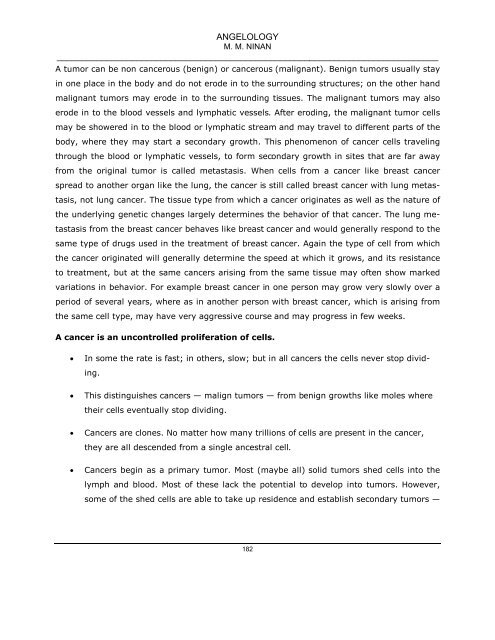Angels, Demons and all the Hosts
Create successful ePaper yourself
Turn your PDF publications into a flip-book with our unique Google optimized e-Paper software.
ANGELOLOGY<br />
M. M. NINAN<br />
_____________________________________________________________________________<br />
A tumor can be non cancerous (benign) or cancerous (malignant). Benign tumors usu<strong>all</strong>y stay<br />
in one place in <strong>the</strong> body <strong>and</strong> do not erode in to <strong>the</strong> surrounding structures; on <strong>the</strong> o<strong>the</strong>r h<strong>and</strong><br />
malignant tumors may erode in to <strong>the</strong> surrounding tissues. The malignant tumors may also<br />
erode in to <strong>the</strong> blood vessels <strong>and</strong> lymphatic vessels. After eroding, <strong>the</strong> malignant tumor cells<br />
may be showered in to <strong>the</strong> blood or lymphatic stream <strong>and</strong> may travel to different parts of <strong>the</strong><br />
body, where <strong>the</strong>y may start a secondary growth. This phenomenon of cancer cells traveling<br />
through <strong>the</strong> blood or lymphatic vessels, to form secondary growth in sites that are far away<br />
from <strong>the</strong> original tumor is c<strong>all</strong>ed metastasis. When cells from a cancer like breast cancer<br />
spread to ano<strong>the</strong>r organ like <strong>the</strong> lung, <strong>the</strong> cancer is still c<strong>all</strong>ed breast cancer with lung metastasis,<br />
not lung cancer. The tissue type from which a cancer originates as well as <strong>the</strong> nature of<br />
<strong>the</strong> underlying genetic changes largely determines <strong>the</strong> behavior of that cancer. The lung metastasis<br />
from <strong>the</strong> breast cancer behaves like breast cancer <strong>and</strong> would gener<strong>all</strong>y respond to <strong>the</strong><br />
same type of drugs used in <strong>the</strong> treatment of breast cancer. Again <strong>the</strong> type of cell from which<br />
<strong>the</strong> cancer originated will gener<strong>all</strong>y determine <strong>the</strong> speed at which it grows, <strong>and</strong> its resistance<br />
to treatment, but at <strong>the</strong> same cancers arising from <strong>the</strong> same tissue may often show marked<br />
variations in behavior. For example breast cancer in one person may grow very slowly over a<br />
period of several years, where as in ano<strong>the</strong>r person with breast cancer, which is arising from<br />
<strong>the</strong> same cell type, may have very aggressive course <strong>and</strong> may progress in few weeks.<br />
A cancer is an uncontrolled proliferation of cells.<br />
• In some <strong>the</strong> rate is fast; in o<strong>the</strong>rs, slow; but in <strong>all</strong> cancers <strong>the</strong> cells never stop dividing.<br />
• This distinguishes cancers — malign tumors — from benign growths like moles where<br />
<strong>the</strong>ir cells eventu<strong>all</strong>y stop dividing.<br />
• Cancers are clones. No matter how many trillions of cells are present in <strong>the</strong> cancer,<br />
<strong>the</strong>y are <strong>all</strong> descended from a single ancestral cell.<br />
• Cancers begin as a primary tumor. Most (maybe <strong>all</strong>) solid tumors shed cells into <strong>the</strong><br />
lymph <strong>and</strong> blood. Most of <strong>the</strong>se lack <strong>the</strong> potential to develop into tumors. However,<br />
some of <strong>the</strong> shed cells are able to take up residence <strong>and</strong> establish secondary tumors —<br />
182


















